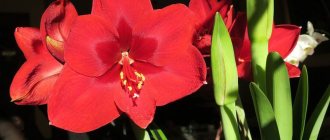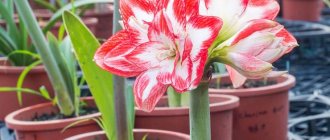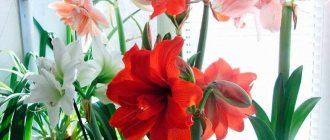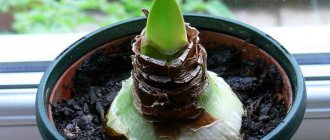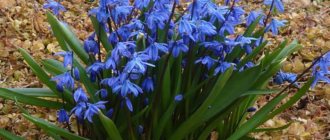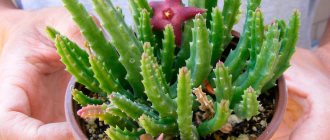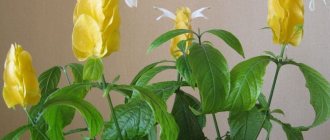Amaryllis is a bulbous flowering plant of the same family. Perennial. Homeland - Olifants River Valley in southern Africa. The distribution area is quite wide. The plant is found in South Africa, Australia, and Japan.
The name of the flower is associated with the famous ancient Roman poet Virgil. Amaryllis, a beautiful shepherdess, appears in his works. From ancient Greek the name is translated as sparkling.
Rules for purchasing in the store
If you decide to buy an adult plant for your home collection, then it is better to purchase it during flowering. This way you can avoid making a mistake with the color and buy the flower you like best. The plant must be healthy and strong, without signs of disease, rot or spots on the leaves.
Purchasing bulbs for growing
It is advisable to buy bulbs in autumn or spring. When choosing, you should pay attention to their appearance. There should be no dry, soft or rotten areas on the bulbs.
Read here which plant varieties are best suited for indoor growing.
Reproduction
Sooner or later, every gardener thinks about how to propagate amaryllis at home. In the wild, it reproduces by seed; the seeds are carried by birds and wind.
- Seed method
We also recommend: Calathea care at home
For the formation of a seed, artificial pollination is required in two stages, less often self-pollination. Then the seed pods ripen. They are collected by hand after cracking, germination remains no more than 6 weeks after ripening, so they are sowed immediately after collection. The seed planting depth is 0.5 cm, at a temperature of plus 22-25°C. After the formation of 2 leaves, the “babies” are transplanted into separate pots.
With the seed method, it will take many years to reach a mature and flowering plant. Varietal characteristics are not preserved
- Vegetative method
A mother bulb older than 5 years gives birth to children, which are separated during transplantation. Most often, children have their own roots and leaves. They are planted in new pots, subject to all conditions of soil, light, heat and watering. Leaves are not trimmed.
- Efficient division method
For division, you will need a mature bulb that has reached 5 years of age. It is cleared of scales, the top and root are cut off. Then it is cut into several vertical parts, soaked in a fungicide solution and germinated separately in the soil under greenhouse conditions (covering the box with polyethylene or glass). Maintaining heat and humidity is important. After 30-60 days, young onions can form from the chopped parts.
- Dividing method without digging
With this method, a mature and healthy bulb is cut into 3-4 parts, down to the root system. Knitting needles or sticks with a diameter of about 5 mm are inserted between the parts. Thus, after a year you can get 4 new plants. Germination conditions +25°C, in diffused and bright light. The varietal characteristics of the new plants remain.
Location and lighting
Amaryllis is very demanding when it comes to lighting. Daylight hours should be at least 16 hours a day. These flowers are always reaching for the sun.
The flower should be placed on south or southeast windows.
In summer, it is necessary to shade it from the scorching rays of the sun to prevent the plant from burning. In winter, it is necessary to ensure that there are no drafts in the room, as they are dangerous for the flower.
Forcing
Experienced flower growers love this representative of the flora because flowering can be created at any desired period . But it is recommended to create a dormant period from the beginning of winter to mid-spring. This is the time that is considered the most optimal and natural for Amaryllis.
At this time, the bulbs are depleted much less and the loss of nutrients occurs with minimal losses. With proper care, the plant will bloom brightly and continuously. And in spring and summer, the planting material bulbs will be able to gain strength for the next season. On an industrial scale, flower forcing is carried out year-round.
Humidity, watering and spraying
The watering schedule depends on the growth period of the plant.
When a flower has a flower shoot of 5-10 cm, the plant should be watered frequently. To avoid overflow, it is advisable to use gentle humidification through a tray. When watering in the usual way, it is necessary to drain off excess water. Otherwise, due to stagnation of moisture, the root system may begin to rot.
After the buds have bloomed, the frequency of moisturizing must be gradually reduced and gradually stop watering altogether.
If the room has normal humidity, then amaryllis does not need constant spraying. This should only be done if the air in the room is dry and the soil dries out very quickly. During the rest phase, you can spray the soil once every 3 weeks to prevent it from drying out completely.
Description of amaryllis
Dark green smooth long leaves are arranged in two rows. The shape is similar to a narrow belt. Inflorescence of an umbrella type.
The root system is a large round bulb, slightly flattened on the sides. Diameter - 5 cm. It is covered with grayish scales, and a dull white rhizome grows from the bottom. The bulb retains its viability for 10–15 years.
The flowering period begins in mid-spring. Duration – 1.5 months. Initially, a fleshy peduncle 0.6 m tall is formed. An inflorescence resembling an umbrella is formed at the top. The shape of the 6-petal flowers resembles a bell. Color: white, cream, pink, yellow, purple-red. In the center there are long stamens and the ovary.
After flowering, fruit boxes are formed, containing more than 6 seeds. They ripen in 30 days.
Landing
Before planting, you need to remove all the dark scales from the bulb so that it becomes light green. After this, the bulb is soaked for 30 minutes in a weak solution of potassium permanganate or any fungicide. Then it is dried for a day and planted in nutritious soil.
Step-by-step instructions for replanting amaryllis can be found here.
Distinctive features of amaryllis
Amaryllis and hippeastrum are often confused. Both plants belong to the same biological group. The genus Hippeastrum is more numerous. It has approximately 90 species found naturally.
The differences between them are presented in the table:
| Comparison sign | Amaryllis | Hippeastrum |
| Bloom | Aug. Sept. | February March. |
| Aroma | It shows up clearly. | Absent. |
| Flower size (diameter in cm) | 10-12 | 6-8 |
| Number of flowers | 4-6. Occurs 12. | 2-4. Maximum – 6. |
| Color | From white to burgundy, there are shades of pink. | Snow-white, lilac, yellow, purple, light green. Variable combination of colors. |
| Presence of leaves in the flowering phase | None. Resume growth after fertilization. | Present. |
| Peduncle | Dense, without voids. Length 0.4-0.6 m. Has a purple tint. | Green hollow tube 70 cm long. Makes a slight cracking noise when pressed. It has a grey-brown color. |
| Bulb shape | Pear-shaped. Covered with gray scales. | Round, elongated at the bottom, slightly compressed on the sides. |
| Motherland | Africa. | South America. |
How to propagate (pictured)?
Reproduction occurs in the following ways:
- Seminal. This is a labor-intensive method, so it is rarely used. To obtain seeds, flowers will have to be pollinated by hand using a brush, transferring pollen from one flower to another. When the seed box dries and cracks, the resulting material can be planted in moist and nutritious soil.
- Daughter bulbs. If cared for correctly, the plant forms daughter bulbs. They are carefully separated and planted in a substrate consisting of sand and peat or perlite. When the bulbs grow, they are transplanted into a larger container.
- By dividing the bulb. At the end of flowering, cut off the neck with leaves from the bulb and divide it into equal parts. Toothpicks or knitting needles are inserted into the cuts. After some time, the formed new bulbs are transplanted. Watch the video to see how this happens:
Decorative flower varieties
Amaryllis - a bulbous flower and its varieties
Currently, selection is carried out in the following areas:
- Increasing the size of the peduncle and the size of the petals.
- Changing the texture of the petals (semi-double, double, super-double crops are produced).
- Obtaining varieties with unusual colors.
- Creation of original shapes of flower petals (corrugated, wavy).
Amaryllis variety Red Lion
The most striking varieties are:
- Amaryllis variety Red Lion was bred by Dutch specialists in 1958. Its green peduncle 40-50 cm high produces 2-4 large bright red flowers with a diameter of 16-18 cm. It blooms in winter. When the Red Lion amaryllis blooms, it never goes unnoticed.
- Spectacular white amaryllis variety Ice Queen. It has large flowers with a creamy coating on the edges of the petals. The spectacular whiteness is enhanced by the gloss of the inflorescences, giving a special shine and radiance. The terry petals are elongated, narrow, sharply pointed at the ends, with wavy and corrugated edges.
- Macarena. A culture with double bright red flowers, 6-8 cm in diameter, with white central stripes.
- Nymph. It has lush double inflorescences reminiscent of peonies. A peduncle about 45 cm long produces lush 3-4 flowers with 12-14 petals up to 25 cm in diameter with wavy edges. There are red strokes and stripes on the cream background of the petals.
- Parker (amaryllis Parker). It has flowers of rich purple-pink color with a yellow radiant center.
- Vera. It grows up to 40 cm in height, has soft pink flowers 7-8 cm in diameter with a pearlescent tint.
- Lady Jane. Introduced in the USA in 1995. On a peduncle 30-55 cm high, 2-4 double flowers of salmon or orange color with white or dark orange stripes with a diameter of 16-20 cm grow.
- Lemon lime. Launched in 1993 in the Netherlands. On a peduncle 45-60 cm high, 3-4 flowers with a diameter of up to 12 cm of lemon-lime color with a wavy edge grow. It blooms 4-6 weeks after planting, produces 2-3 peduncles that are suitable for cutting. After flowering, it forms many leaves 45-55 cm long and 5-6 cm wide, and forms children well.
If you cut the flower stalks during the flowering period, they will last a long time in a vase with water.
Lemon-lime variety
Diseases and pests
The most common pests that can appear on amaryllis are:
- onion mite;
- false scale insect;
- slugs;
- daffodil fly;
- mealybug;
- thrips.
Fungicides and insecticides are used to treat and destroy parasites. They must be used in accordance with the instructions for the drug.
Most often, the plant suffers from fungal diseases, which usually occur when the plant is overwatered and has excess moisture. Red spots or stripes appear on the leaves, peduncle and buds. Foundationazole or a solution of Bordeaux mixture will help get rid of rot.
Problems associated with growing the plant
It is necessary to care for a flower, strictly observing the conditions corresponding to its natural habitat. If this is not ensured, the following problems may occur:
- Fading flowers. Indicates the negative impact of direct sun, and their darkening indicates dampness and cold.
- If the foliage and flowers droop, this means that the plant is not getting enough water.
- Lack of flowering. Caused by a violation of the conditions of detention (no rest period, lack of light or feeding, too cold). If the bulb is too young or too old, or too deep, this can also cause a lack of flowering.
Attention! After flowering has completed, some owners, due to drying of the leaves, begin to intensively feed and water the flower, which ultimately can even lead to its death.
Diseases and pests
Pests can settle on underground and above-ground parts of the plant. The amaryllis scale is a white parasite that reproduces under the scales of the bulb. Because of it, the plant loses its growth and leaves. The means of control are insecticides.
The onion mite lives in the soil and feeds on the pulp of the bulbs. As a result, the leaves of the plant turn yellow and the flowers become smaller. In this case, it is necessary to lower the air temperature and soil humidity.
Mealybugs reproduce on leaves and stems and appear as fluffy white spots. Wet wiping will help deal with this parasite.
False scale insects, which lead to the formation of brown spots on foliage and scales on flowers, are removed with soap solutions or insecticides.
Damage from false scale parasites
If damage occurs caused by fungal diseases, for example, fusarium in the form of rotting roots or staganosporosis in the form of redness of the bulbs, the plant must be isolated, the affected areas removed, the bulbs treated with fungicides and planted in new soil.
Growing this crop is not that difficult. Blooming amaryllis, if planted and cared for on a specific date, can become a valuable gift for a significant life event for a friend or colleague, or decorate the house. A wide range of colors of flowers, surprisingly similar to lilies, but with unique decorative qualities, will satisfy the most demanding taste.
Main difficulties
In order for the arrow of the plant to begin to actively grow from the rosette of leaves, light and thermal conditions must be observed.
This representative of the flora is very light-loving . Prefers warmth. The optimal temperature for the plant varies from 19 to 24°C.
Therefore, if the flower is not provided with such conditions, it will begin to wither and drop its buds. For the formation of a large peduncle, bright natural light is required . When releasing an arrow of a peduncle, Amaryllis needs special watering. It should be moderate.
It is necessary to wait until the top layer of soil dries. It is also necessary to spray the flower with water from a spray bottle . During the period of active growth, the plant is fed. Fertilizers for home flowers are suitable for this. After flowering and falling of the peduncle, fertilizing must be stopped.
Listen to the article
Modern gardeners are not afraid of difficulties, because lovers of garden bulbous flowers undertake to grow not only traditional tulips, lilies or daffodils. They are not afraid to grow such truly exotic flowers as amaryllis or hippeastrum, which attract with the luxurious, incredibly bright colors of large, amazingly shaped flowers. However, we need to immediately clarify: almost all the beautiful flowers that we grow or buy under the name amaryllis are actually hippeastrums or hybrids of hippeastrum and amaryllis.
These flowers, unlike most bulbous ones, bloom in August-September, but gardeners are attracted by the possibility of forcing and flowering these flowers at other times of the year.
What kind of pot do you need?
The main rule for choosing a planting container is a narrow and tall pot, the optimal size is a container of 2 rubles. more onion. It is preferable to use plastic pots.
In a spacious container, the plant grows its root system and aerial parts , produces “babies”, but delays flowering (it may even refuse to produce a peduncle).
Feature - the pot must be stable (there is drainage and weights at the bottom) - a large plant with a tall stem may fall over.
Temperature
Temperature conditions during active growth:
- Daytime 20–22° C;
- At night no less than 18° C.
During the dormant period, amaryllis bulbs should be kept in a cool place . The optimal temperature will be about 15° C, the minimum 10° C, and the maximum 18° C. At low temperatures, the bulb may die, and at high temperatures, it may germinate too quickly, not allowing the plant to fully rest.
In summer, it is not advisable to take the flower out of the room, since differences in day and night temperatures in the middle zone can be significant. This plant does not like sudden decreases or increases in temperature, which can lead to a lack of flowering.
This flower requires a period of rest. But it is not always possible to keep a flower in a cold room. In order for amaryllis to successfully overwinter and produce a peduncle in the spring, it can be kept at room temperature 20-22ºС, but in relative dryness. In this case, the flower will not grow in winter.
